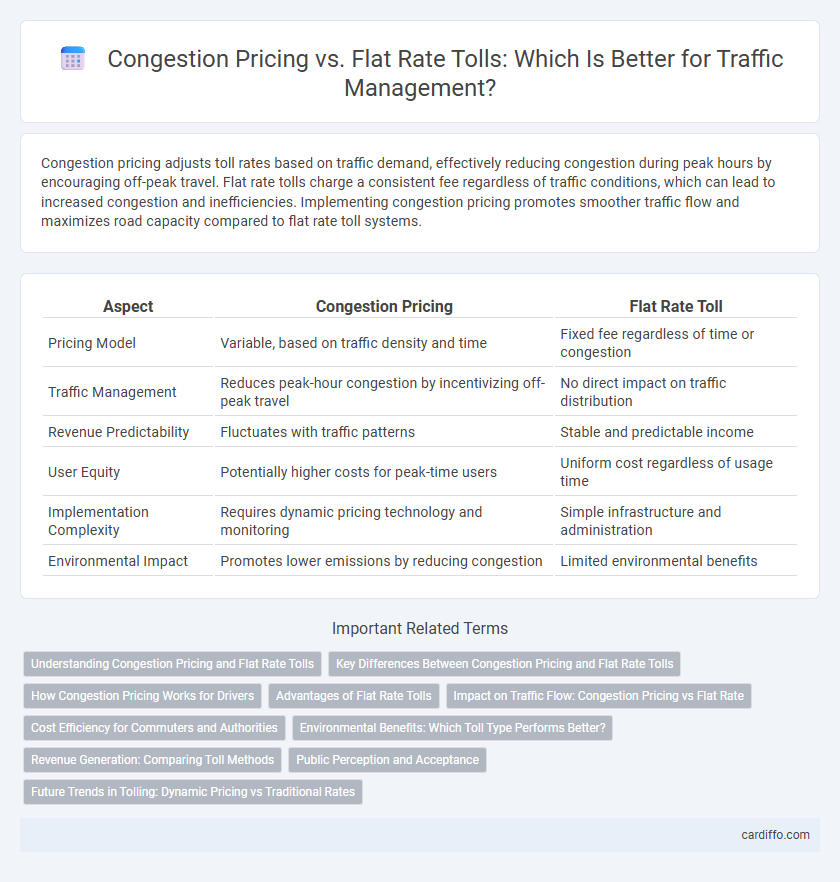Congestion pricing adjusts toll rates based on traffic demand, effectively reducing congestion during peak hours by encouraging off-peak travel. Flat rate tolls charge a consistent fee regardless of traffic conditions, which can lead to increased congestion and inefficiencies. Implementing congestion pricing promotes smoother traffic flow and maximizes road capacity compared to flat rate toll systems.
Table of Comparison
| Aspect | Congestion Pricing | Flat Rate Toll |
|---|---|---|
| Pricing Model | Variable, based on traffic density and time | Fixed fee regardless of time or congestion |
| Traffic Management | Reduces peak-hour congestion by incentivizing off-peak travel | No direct impact on traffic distribution |
| Revenue Predictability | Fluctuates with traffic patterns | Stable and predictable income |
| User Equity | Potentially higher costs for peak-time users | Uniform cost regardless of usage time |
| Implementation Complexity | Requires dynamic pricing technology and monitoring | Simple infrastructure and administration |
| Environmental Impact | Promotes lower emissions by reducing congestion | Limited environmental benefits |
Understanding Congestion Pricing and Flat Rate Tolls
Congestion pricing adjusts toll rates based on traffic demand, reducing peak-hour congestion by encouraging off-peak travel and optimizing road usage. Flat rate tolls charge a fixed fee regardless of time or traffic conditions, providing predictable costs but potentially contributing to peak-hour traffic jams. Understanding the differences between these toll systems highlights the balance between traffic management effectiveness and user cost predictability.
Key Differences Between Congestion Pricing and Flat Rate Tolls
Congestion pricing adjusts toll rates based on traffic demand, charging higher fees during peak hours to reduce congestion and encourage off-peak travel. Flat rate tolls impose a fixed fee regardless of time or traffic conditions, providing simplicity but lacking incentives for demand management. Key differences include dynamic pricing in congestion pricing versus static fees in flat rate tolls, impacting traffic flow efficiency and revenue optimization.
How Congestion Pricing Works for Drivers
Congestion pricing adjusts toll rates based on real-time traffic demand, charging higher fees during peak hours to reduce road congestion. Drivers experience variable costs that encourage off-peak travel, helping to optimize traffic flow and decrease travel times. This system uses dynamic pricing algorithms and traffic sensors to manage roadway usage efficiently, benefiting both commuters and urban infrastructure.
Advantages of Flat Rate Tolls
Flat rate tolls offer simplicity in administration and predictability for drivers, enabling easier budgeting and reducing confusion compared to congestion pricing models. They ensure equitable access regardless of travel time, benefiting commuters who travel during peak hours without facing fluctuating costs. This toll structure also encourages consistent traffic flow and minimizes the need for complex monitoring and enforcement systems.
Impact on Traffic Flow: Congestion Pricing vs Flat Rate
Congestion pricing dynamically adjusts toll rates based on real-time traffic conditions, effectively reducing peak-hour congestion by incentivizing off-peak travel and optimizing road capacity. Flat rate tolls impose a fixed charge regardless of traffic volume, often leading to steady bottlenecks during high-demand periods due to lack of demand management. Studies show congestion pricing lowers average travel times and vehicle density on highways compared to flat rate systems, improving overall traffic flow efficiency.
Cost Efficiency for Commuters and Authorities
Congestion pricing optimizes cost efficiency by charging variable tolls based on traffic demand, reducing peak-hour congestion and lowering overall travel times for commuters. This dynamic approach generates higher revenue for authorities by incentivizing off-peak travel and better managing road capacity. Flat rate tolls provide predictable expenses but often lead to inefficient road usage and increased congestion costs, diminishing economic benefits for both commuters and transportation agencies.
Environmental Benefits: Which Toll Type Performs Better?
Congestion pricing reduces vehicle emissions by charging higher tolls during peak traffic hours, encouraging off-peak travel and decreasing overall traffic volume, which leads to improved air quality. Flat rate tolls generate consistent revenue but do not provide incentives to change driving behavior, often resulting in persistent traffic congestion and higher pollution levels. Studies show that congestion pricing significantly outperforms flat rate tolling in reducing carbon emissions and promoting sustainable urban transportation.
Revenue Generation: Comparing Toll Methods
Congestion pricing optimizes revenue by adjusting toll rates based on traffic demand, effectively managing peak-hour congestion while maximizing income. Flat rate tolls generate consistent revenue but often fail to reflect variations in traffic flow, potentially leading to underutilization during off-peak hours. Implementing congestion pricing results in higher overall toll revenue and improved traffic distribution compared to fixed flat rate tolling systems.
Public Perception and Acceptance
Public perception of congestion pricing tends to be more favorable than flat rate tolls when people recognize benefits such as reduced traffic congestion and improved air quality. Flat rate tolls are often perceived as unfair because they charge all drivers the same amount regardless of travel time or traffic conditions, leading to lower acceptance rates. Studies indicate that transparent communication about how congestion pricing revenues are reinvested in transportation infrastructure significantly increases public acceptance.
Future Trends in Tolling: Dynamic Pricing vs Traditional Rates
Dynamic pricing in tolling leverages real-time traffic data and advanced algorithms to adjust toll rates, optimizing road usage and reducing congestion more effectively than flat rate tolls. Future trends indicate a shift towards congestion pricing models that balance demand and supply, encouraging off-peak travel and enhancing traffic flow. Traditional flat rate tolls, while simpler, often fail to reflect varying traffic conditions, leading to less efficient road network management.
Congestion Pricing vs Flat Rate Toll Infographic

 cardiffo.com
cardiffo.com